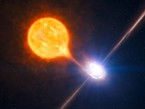Aeson
Posts: 784
Joined: 8/30/2013
Status: offline

|
Just so you know, completing a Defense Mission does not actually require you to keep a fleet close to the target of the Defense Mission. What it requires you to do is prevent other pirates from raiding the planet, which is very, very difficult unless you've more or less eliminated other pirate factions from the area or have a strong enough presence around the target of the defense mission to run off interlopers before they can launch assault pods. I believe that there is some room for error in the current version, but it's not a very forgiving mission type. A suggestion from the pirate guide over in the War Room is actually to build Defense Bases over colonies you'd like to control rather than posting fleets at those locations, which probably isn't a bad idea if you can afford it.
Regarding Resupply Ships and fuel gases: To my understanding, a Resupply Ship will always reserve about half its cargo space for each fuel gas regardless of whether it's over a pure source of the fuel you want or is deployed in a location with both gases. As a result, you don't really need to worry about it wasting cargo space on fuels you're not going to be using.
Regarding mining stations: I personally would suggest that if you're going to build mining stations, you should build ones which mine resources which are not available from independent colonies in your area. Independent colonies with resource deposits are essentially upkeep-free mines from which your freighters can gather resources for your construction needs or smuggling, and moreover will (almost?) never post smuggling resources for the resources which the colony can produce locally.
Regarding tractor beam "damage:" The "damage" listed for the tractor beam is essentially the push or pull strength. I'm not entirely certain, but the number might be the speed at which the target moves relative to your ship when affected by a tractor beam. The positive number might be maximum pull strength while the negative number might be maximum push strength. I am however unsure as to exactly how tractor beams work, and they do have a listed loss of 'power' with increasing range which can drive the 'pull power' of the tractor beam negative by maximum range.
A note on engagement stance settigns: "All weapons" causes the ship to move to just inside the maximum range of its shortest-ranged weapon, while "standoff" causes the ship to move to just inside the maximum range of its longest-ranged weapon. If you have a ship whose shortest-ranged weapon has the same range as its longest-ranged weapon, as is the case for ships with only one type of weapon, "all weapons" and "standoff" are functionally the same stance.
Also, engagement range is measured to a single target. If you are paying attention to the battles and you happen to have a situation where your fleet cannot close to within firing range of a hostile missile ship, and you can identify which of your ships is the primary target of the hostile missile ship, order that ship to move away from the enemy missile ship while ordering the rest of your ships to attack the missile ship. The enemy missile ship will move to stay within range of its primary target even if it means diving into the middle of the rest of your fleet.
A note on firepower: While I think you've noticed this, firepower is not exactly a great metric for a ship's offensive power. A ship's rated firepower is equal to the sum of the rated damage values for each of its weapons, with nothing else factored in. To illustrate why this can be a bit deceptive, let's look at the theoretical DPS by listed rate of fire (theoretical DPS by projectile travel time will be listed in parenthesis if lower) per component of the initial versions of Maxos Blasters, Epsilon Torpedoes, and Concussion Missiles at minimum range, maximum blaster range (190), maximum torpedo range (300), and maximum missile range (520), using numbers from the unmodded game. At minimum range, theoretical DPS is 4.03 for Maxos Blasters, 3.79 for Epsilon Torpedoes, and 2.22 for Concussion Missiles; at maximum blaster range, theoretical DPS is 2.5 for Maxos Blasters, 1.83 (1.67) for Epsilon Torpedoes, and 2.22 for Concussion Missiles; at maximum torpedo range, theoretical DPS is 0.69 (0.40) for Epsilon Torpedoes and 2.22 for Concussion Missiles; at maximum missile range, theoretical DPS is 2.22 (1.38) for Concussion Missiles. Rated firepower per component is 5 for Maxos Blasters, 11 for Epsilon Torpedoes, and 6 for Concussion Missiles (per size invested, that's 1, 0.73, and 0.6 respectively). In theory, you can fit six Maxos Blasters or three Concussion Missiles for every two Epsilon Torpedoes in the design, though in practice that'll be more like 4-5 Maxos Blasters or 1.5-2 Concussion Missiles for every two Epsilon Torpedoes due to the difference in power requirements. Practically speaking, then, a ship armed with Epsilon Torpedoes should have a similar rated firepower to a ship armed with Maxos Blasters or a ship armed with Concussion Missiles, if all three ships are about the same size and have similar speeds and reactor outputs. If we look at the DPS per component and translate that to practice, then, a blaster-armed ship will have roughly double the theoretical DPS of a torpedo-armed ship inside blaster range, and a missile-armed ship will have roughly double the theoretical DPS of a torpedo-armed ship outside of blaster range. In trying to do everything, all generalists run the risk of being unable to do anything well, or even adequately, and the initial version of the Epsilon Torpedo definitely fell into this trap when comparing it to the initial versions of the Maxos Blaster and Concussion Missile. Later torpedoes do a much better job of striking a balance between long- and short-range performance, in part because they don't sacrifice nearly as much range relative to similarly-advanced missiles and in part because later torpedoes aren't nearly as large as the Epsilons are.
< Message edited by Aeson -- 2/3/2017 7:28:27 PM >
|
 Printable Version
Printable Version









 New Messages
New Messages No New Messages
No New Messages Hot Topic w/ New Messages
Hot Topic w/ New Messages Hot Topic w/o New Messages
Hot Topic w/o New Messages Locked w/ New Messages
Locked w/ New Messages Locked w/o New Messages
Locked w/o New Messages Post New Thread
Post New Thread